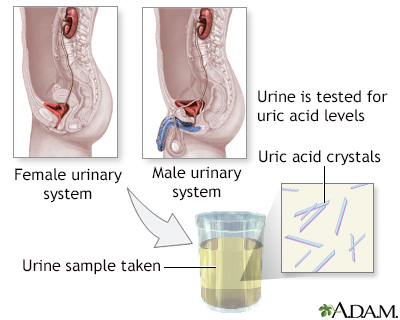Uric acid urine test
Definition
The uric acid urine test measures the level of uric acid in urine.
Uric acid level can also be checked using a blood test.
How the Test is Performed
A 24-hour urine sample is often needed. You will need to collect your urine over 24 hours. Your health care provider will tell you how to do this. Follow instructions exactly.
How to Prepare for the Test
Your provider may ask you to temporarily stop taking medicines that may affect the test results. Be sure to tell your provider about all the medicines you take. These include:
- Aspirin or aspirin-containing medicines
- Gout medicines
- Nonsteroidal anti-inflammatory drugs (NSAIDs, such as ibuprofen)
- Water pills (diuretics)
DO NOT stop taking any medicine before talking to your provider.
Be aware that alcoholic drinks, vitamin C, and x-ray dye can also affect test results.
How the Test will Feel
The test involves only normal urination. There is no discomfort.
Why the Test is Performed
This test may be done to help determine the cause of a high uric acid level in the blood. It may also be done to monitor people with gout, and to choose the best medicine to lower the uric acid level in the blood.
Uric acid is a chemical created when the body breaks down substances called purines. Most uric acid dissolves in blood and travels to the kidneys, where it passes out in urine. If your body produces too much uric acid or does not remove enough of it, you may get sick. A high level of uric acid in the body is called hyperuricemia and it can lead to gout or kidney damage.
This test may also be done to check whether a high uric acid level in the urine is causing kidney stones.
Normal Results
Normal values range from 250 to 750 mg/24 hours (1.48 to 4.43 mmol/24 hours).
Normal value ranges may vary slightly among different laboratories. Some labs use different measurements or test different samples. Talk to your doctor about the meaning of your specific test results.
What Abnormal Results Mean
A high uric acid level in the urine may be due to:
- Body not being able to process purine (Lesch-Nyhan syndrome)
- Certain cancers that have spread (metastasized)
- Disease that results in breakdown of muscle fibers (rhabdomyolysis)
- Disorders that affect the bone marrow (myeloproliferative disorder)
- Disorder of the kidney tubes in which certain substances normally absorbed into the bloodstream by the kidneys are released into the urine instead (Fanconi syndrome)
- Gout
- High-purine diet
A low uric acid level in the urine may be due to:
- Chronic kidney disease that impairs the kidneys' ability to get rid of uric acid, which can lead to gout or kidney damage
- Kidneys that are not able to filter fluids and waste normally (chronic glomerulonephritis)
- Lead poisoning
- Long-term (chronic) alcohol use
Risks
There are no risks with this test.
Gallery


References
Dalbeth N. Clinical features and treatment of gout. In: Firestein GS, Budd RC, Gabriel SE, Koretzky GA, McInnes IB, O'Dell JR, eds. Firestein and Kelley's Textbook of Rheumatology. 11th ed. Philadelphia, PA: Elsevier; 2021:chap 101.
Riley RS, McPherson RA. Basic examination of urine. In: McPherson RA, Pincus MR, eds. Henry's Clinical Diagnosis and Management by Laboratory Methods. 24th ed. Philadelphia, PA: Elsevier; 2022:chap 29.